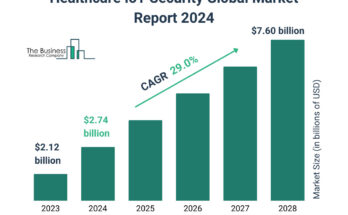According to TechSci Research’s report titled “India Telemedicine Market – Industry Size, Share, Trends, Competition Forecast & Opportunities, 2029,” the India Telemedicine Market reached a valuation of USD 1.54 Billion in the year 2023. This market is projected to experience robust growth, with a Compound Annual Growth Rate (CAGR) of 20.75% anticipated in the forecast period from 2025 to 2029. The expansion of the telemedicine sector in India can be attributed to a multitude of factors that have collectively fostered its rapid development.
Internet and Smartphone Penetration: The proliferation of the internet and the widespread adoption of smartphones have significantly enhanced the accessibility of healthcare services, particularly in remote and underserved areas where physical access to healthcare facilities may be limited. This technological advancement has effectively bridged the geographical gap, enabling individuals in distant regions to access medical consultations and advice from healthcare professionals through telemedicine platforms.
Browse over XX market data Figures spread through XX Pages and an in-depth TOC on “India Telemedicine Market.” – https://www.techsciresearch.com/report/india-telemedicine-market/7374.html
Government Initiatives: The Indian government’s digital health initiatives have played a pivotal role in promoting the adoption of telemedicine in the country. Telemedicine has emerged as a convenient and cost-effective solution, providing Indian citizens with access to quality healthcare without the need for extensive travel or enduring long waiting times. The combination of increased internet and smartphone usage, complemented by the government’s digital health programs and supportive regulations, has fueled the growth of the telemedicine market, thereby bringing healthcare services closer to those who need them the most.
Transformative Healthcare Landscape: The India telemedicine market is undergoing a significant transformation, becoming a pivotal sector within the nation’s healthcare landscape. By harnessing the capabilities of information technology and telecommunications, telemedicine facilitates the remote delivery of healthcare services, effectively revolutionizing the accessibility and delivery of healthcare services in India. This innovative approach is propelled by factors such as the increasing internet penetration, the rising prevalence of chronic health conditions, and the government’s proactive initiatives to enhance healthcare accessibility.
Overcoming Geographical Barriers: Telemedicine effectively overcomes geographical barriers, thereby playing a critical role in extending timely medical care to rural and underserved regions. It empowers individuals to access healthcare services conveniently, effectively addressing limitations related to distance and physical infrastructure.
Addressing Healthcare Disparities: Telemedicine not only improves healthcare outcomes but also addresses the prevalent healthcare disparities across the country. It has the potential to revolutionize specialized healthcare services, such as telepathology for remote diagnosis, telepsychiatry for mental health support, and telecardiology for remote monitoring of heart conditions. This technology-driven approach opens up new possibilities for patients who previously faced limitations in accessing specialized care due to geographic constraints.
Continuous Advancements and Innovations: With continuous advancements and innovations in telemedicine, the future of healthcare in India looks promising. These innovations include the integration of artificial intelligence and machine learning algorithms in telemedicine platforms, which can enhance diagnostic accuracy and personalized treatment plans. Additionally, the adoption of telemedicine in rural areas can lead to better preventive care and early intervention, reducing the burden on healthcare facilities and improving overall population health.
Challenges and Collaborations: As telemedicine continues to evolve, addressing challenges related to data privacy, security, and regulatory frameworks is crucial to ensure the safe and effective implementation of telemedicine services. Collaborations between healthcare providers, technology companies, and policymakers are essential to create an ecosystem that supports the growth and sustainability of telemedicine in India. Telemedicine is reshaping the healthcare landscape in India, providing opportunities to optimize healthcare delivery, improve patient outcomes, and bridge the gap in access to quality healthcare services. With its transformative potential, telemedicine holds the promise of a healthier and more connected future for all individuals in India.
The India Telemedicine Market is further segmented into various categories, including component, deployment mode, type, technology, delivery mode, application, end user, regional distribution, and companies operating within the sector. Here, we will provide a more detailed analysis of the key segments, specifically focusing on the “end user” and “regional distribution.”
End User Segmentation:
- Providers: Among the key end users in the India telemedicine market, providers are anticipated to dominate the scene. This is primarily attributed to their pivotal role in delivering telehealth services and the increasing adoption of digital technology among healthcare providers. Providers play a vital role in ensuring that patients receive quality healthcare remotely, leveraging innovative solutions and advanced digital platforms. They are at the forefront of revolutionizing healthcare delivery by bridging the gap between patients and doctors through telemedicine.
- Patients: Patients are another essential end user segment in the telemedicine market. They benefit from the convenience and accessibility of telemedicine, allowing them to receive medical consultations and care from the comfort of their homes. Especially during the ongoing pandemic, remote patient monitoring and consultation have become crucial for ensuring access to healthcare services while maintaining social distancing and minimizing in-person visits.
- Payers: The third key end user group includes payers, which can include insurance companies or healthcare payment organizations. They play a role in facilitating payments for telemedicine services and ensuring that patients are covered for telehealth consultations and treatments.
Customers can also request for 10% free customization on this report.
Regional Distribution:
- North India: Currently, North India stands as the dominant region in the Indian Telemedicine Market. Several factors contribute to this dominance. Firstly, the region boasts a higher penetration rate of technology and internet services, allowing for seamless connectivity between patients and healthcare providers. This advanced technological infrastructure ensures that telemedicine services can reach even the most remote areas, providing healthcare access to underserved populations.
- Moreover, there is a greater awareness about the benefits and potential of telemedicine among the population in North India. The increasing adoption of smartphones and digital devices has made people more comfortable with using telemedicine platforms for their healthcare needs. The convenience and cost-effectiveness of telemedicine have also contributed to its popularity in the region.
- Additionally, the presence of leading healthcare and IT companies in North India has further propelled the growth of telemedicine. These companies bring expertise and resources to develop and implement advanced telemedicine solutions. Collaborations between healthcare providers and technology companies have resulted in innovative telemedicine platforms that offer a wide range of services, from remote consultations to remote monitoring of patients’ vital signs.
- The availability of a skilled workforce in North India has also played a significant role in driving the success of telemedicine initiatives. The region is known for its highly trained healthcare professionals and IT specialists, who have embraced telemedicine as a means to expand their reach and provide quality healthcare services to a larger population.
- Furthermore, the higher population density in the region has provided a larger patient base for telemedicine services. With a larger number of potential users, telemedicine providers in North India have been able to scale their services and offer a wide range of specialized healthcare solutions. This increased demand for remote healthcare solutions has encouraged the development and expansion of telemedicine infrastructure in North India.
- Government initiatives promoting digital health solutions, particularly in urban areas, have been instrumental in fostering the growth of the telemedicine market in North India. The government has invested in creating a supportive regulatory framework, ensuring the privacy and security of telemedicine platforms. Incentives and subsidies have also been provided to healthcare providers to adopt telemedicine practices, making it more accessible and affordable for both providers and patients.
- The combination of higher technology penetration, awareness, presence of key industry players, population density, and government support has positioned North India as a dominant force in the Indian Telemedicine Market. With its robust telemedicine infrastructure and a skilled workforce, North India is poised to lead the way in leveraging technology to revolutionize healthcare delivery.
The India Telemedicine Market is experiencing rapid growth, driven by a convergence of factors, including technological advancements, government initiatives, and increasing awareness among both healthcare providers and patients. The sector’s ability to overcome geographical barriers and address healthcare disparities makes it a critical component of the nation’s healthcare ecosystem. As telemedicine continues to evolve and innovate, it holds the potential to further enhance patient outcomes, optimize healthcare delivery, and ensure equitable access to quality healthcare services for all individuals in India. Addressing challenges related to data privacy, security, and regulatory frameworks is essential to ensure the safe and effective implementation of telemedicine services. Collaborations between key stakeholders are pivotal in creating an ecosystem that supports the growth and sustainability of telemedicine in India. The future of healthcare in India looks promising, with telemedicine playing a central role in achieving a healthier and more connected future for the nation’s population.
Major companies operating in India Telemedicine Market are:
- Apollo Tele Health Services Pvt. Ltd.
- Practo Technologies Pvt.Ltd.
- TATA 1MG Healthcare Solutions Pvt.Ltd.
- DocOnline Health India Pvt Ltd.
- Lybrate India Pvt.Ltd.
- Netdox Health Pvt. Ltd.
- Allscripts Healthcare Technologies Pvt. Ltd.
- Dhanush Digital Health Pvt. Ltd.
- Novocura Tech Health Services Pvt. Ltd.
- Zoylo DigiHealth Pvt. Ltd.
Customers can also request for 10% free customization on this report.
“The future of the Indian telemedicine market is not only predicted to be robust and thriving but also holds immense potential for transforming healthcare delivery across the country. With advancements in technology and increased internet penetration, telemedicine is poised to revolutionize the way healthcare is accessed and delivered in India. By leveraging digital platforms and communication tools, telemedicine can bridge the gap between patients and healthcare providers, ensuring timely access to medical expertise, diagnosis, and treatment even in remote areas. Furthermore, the vast geographical expanse of India and the disparity in healthcare infrastructure between urban and rural areas make telemedicine a particularly effective solution. In addition to technological advancements and the need for healthcare accessibility in rural areas, government initiatives play a crucial role in driving the growth of the Indian telemedicine market. The National Telemedicine Network, launched by the government, aims to establish a robust telemedicine infrastructure across the country, connecting healthcare providers and patients seamlessly. This initiative not only enhances the reach of telemedicine but also ensures the delivery of quality healthcare services to even the remotest corners of India. Considering these factors, the Indian telemedicine market is anticipated to experience a significant surge in the coming years, transforming the healthcare landscape and providing accessible and affordable healthcare solutions to millions of people across the country.,” said Mr. Karan Chechi, Research Director with TechSci Research, a research-based management consulting firm.
“India Telemedicine Market By Component (Services & Software, Hardware), By Deployment Mode (Cloud, On-Premise), By Type (Tele-Hospitals, mHealth, Tele-Homes), By Technology (Store & Forward, Real Time, Others), By Delivery Mode (Audio-Visual, Only Audio, Written), By Application (Tele-Psychiatry, General Consultations, Tele-Radiology, Tele-Pathology, Others), By End User (Patients, Provider, Payers), By Region, Competition, Forecast & Opportunities, 2019-2019F”, has evaluated the future growth potential of India Telemedicine Market and provides statistics & information on market size, structure and future market growth. The report intends to provide cutting-edge market intelligence and help decision makers take sound investment decisions. Besides, the report also identifies and analyzes the emerging trends along with essential drivers, challenges, and opportunities in India Telemedicine Market.
Download Free Sample Report – https://www.techsciresearch.com/sample-report.aspx?cid=7374
Recently Published Reports –
India Telemedicine Market
India Blood Warmer Devices Market
India Healthcare Analytics Market
Contact Techsci Research-
US –
Mr. Ken Mathews
708 Third Avenue,
Manhattan, NY,
New York – 10017
Tel: +1-646-360-1656
Germany –
S-01, 2.floor, Subbelrather Straße,
15a Cologne,
Germany 50823
Tel: +49 221 65058833
Email: [email protected]
Web: https://www.techsciresearch.com



